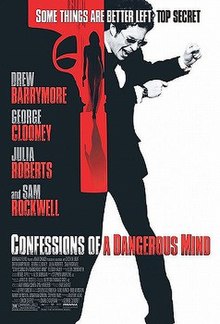 🍿 | 🎙️ EPISODE 426: 03.21.22 *begins ~19:53 Ugh. It's been a minute since I reviewed a bonafide, "hold your nose!" stinker. I would call this movie a skunk, but that would be an insult to skunks! But seeing how this is George Clooney's directorial debut I'm willing to cut the young up-and-comer some slack, because it's har—HE MADE 7 MORE FILMS AFTER THIS?? Shocking they let this inept twit, I mean this bastion of Hollywood royalty get a 2nd, 3rd, 4th, 5th, 6th, 7th, and even 8th (!) chance, but haha I'm doing a bit none of this is shocking at all of course. The bitch of it is that I only watched this to complete my Charlie Kaufman filmography series, and the moral is clear as day: some stones should remain unturned. Or in this case, sometimes Dick Clark's hot pink saturated face should not be seen... |
The Horror. As discussed in my Being the Ricardos review, this odd device: inserting documentary talking head style interview clips into an otherwise straight narrative biopic SHOULD NEVER BE DONE. Thankfully this trope is a very rare one, but it is still one of the absolute worst. I would love to see an example where it is deployed successfully or at least in a manner where it didn't seem like the subjects were full-on acting. Admittedly, the clips in Being the Ricardos felt way more forced, like they were reading cue cards, but the garish color-grading makes this a twofold sin. And lest you thought this strange, highly 00s choice to crank the saturation to a million or otherwise fuck with the color in postproduction was reserved for these sparse, jarring insertions, oh boy are you in luck! Nearly every sequence in this nonlinear film has had its color tweaked. This, naturally, is a device that — on the surface at least — seems to have a purpose. The flashbacks to the 1940s, well those are cloaked in sepia. Germany or Helsinki? Well those are cold, foreign places so let's make those look blue. And how bout some sickening brightness for the fun-loving early 60s NYC shots, can you do that? Sure can. All of this is well and good, and — while it's not my favorite, and I can easily pass it off as a trend of its time (Scorsese's Bringing Out the Dead suffered from this early 00s "music-video-itis," as well) — its utilized with a stunning inconsistency. Mostly, yes, the childhood flashbacks are all in sepia, unless they are in grainy black-and-white. All the European shots are blue, except when they are indoors and occasionally when it's daylight. Know that this isn't a hard story to follow necessarily, so doing this AT ALL was a stylistic choice. Many people signed off on this horrid-looking mess. It's frankly amazing. It's beyond distracting. It gave me a headache. Here's a quick collage of the various looks this film tries on...

And that's just truly a random sample.
I was going to do a beat-by-beat review of what else is wrong here (and there is SO MUCH wrong) but honestly it's not even worth my/your time. Just check out this Crazy Surreal sequence toward the end...
Jesus christ, this movie is a lot. You know that it's cool, though, because of HOW CRAZY IT IS. Isn't dream/hallucination scene crazy? When the whole audience was dead and bloody for some reason? Do you know what that means, man? This is truly a movie to make you hate movies.
For the most, the performances are alright given the daunting constraints: Rutger Hauer is always cool to see; I'm genuinely a fan of Sam Rockwell; and Drew Barrymore is solid and sweet as usual. But I've never been a fan of Clooney as an actor (this guy is a double threat, in that he's doubly bad at both acting AND directing), and Julia Roberts.... Poor Julia Roberts somehow OK'd this kissing scene. Is this supposed to be comedic?
... e n h a n c e ...

And all the editing choices, and nauseating pace issues aside, this is the film's biggest flaw structurally and tonally. It isn't funny AT ALL, and furthermore, I can't even figure out if it's trying to be. I don't mean to keep harping on it, but this is a case where the twenty years removed is extremely meaningful. This was generally well-liked when it came out. It wasn't a smash hit but the critics mostly dug it (Ebert gave it 3.5 stars!). All of its brash and flashy aesthetic choices would not have seemed so crazy or messy at the times. I'm finding more and more that films of a very specific era (maybe 1999-2004?) just looked like this. And we were all OK with it for some reason.
On Wikipedia it says, "Kaufman criticized Clooney for making drastic alterations to the script without consulting him (instead, Clooney consulted Barris)" and, welp, that's good enough for me. I hereby declare that we strike Confessions of a Dangerous Mind from the record. This was never a film Charlie Kaufman had ANY involvement with. So let it be written; so let it be done.
CHRONOLOGICALLY
⫷ EPISODE 426A - (YOU ARE HERE) - EPISODE 427A ⫸
⫷ EPISODE 426A - (YOU ARE HERE) - EPISODE 427A ⫸
Confessions of a Dangerous Mind is a 2002 American neo-noir biographical spy mystery comedy-drama film depicting the fictional life of game show host and producer Chuck Barris. The film was George Clooney's directorial debut, was written by Charlie Kaufman and starred Sam Rockwell as Barris, as well as Julia Roberts, Drew Barrymore, and Clooney. It is based on Barris's 1984 "unauthorized autobiography" of the same name, in which he claimed to have been an assassin for the CIA in addition to his show business career. These allegations have been denied by the CIA, while Barris throughout his life generally refused to say whether the claim was true or not. It was released on December 31, 2002.

0 comments:
Post a Comment